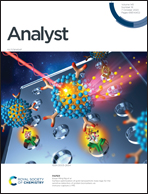A simple enzyme-catalyzed reaction induced “switch” type fluorescence biosensor based on carbon nitride nanosheets for the assay of alkaline phosphatase activity
Abstract
An enzyme-catalyzed fluorescence “switch” type sensor was constructed for the determination of alkaline phosphatase (ALP) activity by combining the fluorescence quenching effect of Ag+ on ultrathin g-C3N4 nanosheets (CNNSs) with the simple redox reaction of AA and Ag+. Briefly, Ag+ exhibits a significant quenching effect on the fluorescence of CNNSs. Thus the fluorescence signal of the CNNS-Ag+ system is extremely weak even in the presence of L-ascorbic acid-2-phosphate (AAP) (“off” state). When ALP coexists in the system, the enzyme can specifically catalyze the hydrolysis of AAP to form ascorbic acid (AA), which reduces Ag+ to Ag0. In this case, the fluorescence signal of the system is recovered (“on” state). Based on this principle, a signal-enhanced CNNS fluorescence sensor was developed to determine the activity of alkaline phosphatase. The experimental results show that the detection range of alkaline phosphatase is 0.5–20 U L−1, and the detection limit is 0.05 U L−1 (S/N = 3). Meanwhile, this method was used to assay ALP in serum samples.



 Please wait while we load your content...
Please wait while we load your content...